An essential element of continual, evolving midwifery is the need for midwives to critically reflect on their practice in order to inform and improve care for childbearing women. Reflection involves learning through everyday experiences and forms an integral part of undergraduate and post-graduate higher education midwifery programmes. It is an in-depth view of events, whereby the reflector reviews a situation and attempts to work out what happened, what they felt or thought about it, who or what influenced particular actions and how they would respond if it happened again. Reflection supports life-long learning by cultivating insight into professional practice, increasing self-awareness and allowing for deeper understanding of analysis and evaluation to strengthen critical inquiry and inform practice (Kirkham, 1997).
Reflection can be defined as ‘to think, meditate or ponder’, and is a philosophical understanding of how we gain knowledge through experience (Johns, 2009). The concept of reflective thinking as part of learning as initiated by the philosopher and educationalist John Dewey, who defined it as:
‘Active, persistent and careful consideration of any belief or supposed form of knowledge in the light of the grounds that support it and the further conclusion to which it tends.’
Dewey described reflection as a process that enabled learning from a continued series of experiences from which continuity of meaning occurs over time (Ramsden, 1992). He proposed that reflective thinking involved a systematic, scientific process of describing an experience, articulating questions that arise from that experience to generate theories or hypotheses, and then taking intelligent action to test such theories (Ramsden, 1992). This concept of reflective thinking was, however, largely placed within the context of education, where students aim to gain knowledge and understanding through learning (Kember et al, 2001). In a professional context, reflection is known to be of benefit in experiential learning, and for the development of critical thinking skills, which facilitate the integration between theory and practice (Royal College of Midwives (RCM), 2009).
Reflection involves identifying accomplishments within a situation in order to look forward. It heightens self-awareness and allows practitioners to see things clearly and make the best decisions (Johns, 2009). It also provides a useful focus because it enables one to explore the influences that shape and guide individual practice (Kirkham, 1997). When used well, reflection enables learning, and within professional practice it allows practitioners to demonstrate their progression to achieve learning outcomes and required standards (Heyer, 2015).
Models of reflection
Reflection provides a structure in which to evaluate learning, allowing theories and concepts to become entrenched in practice, and fostering continual thought and innovation (Heyer, 2015). There are many different models of reflection but the work of Gibbs (1988), SchÖn (1983), Kolb (1984) and Johns (2000) are particularly relevant to midwifery and nursing education.
Gibbs (1988)
Gibbs developed the idea of a reflective cycle to encourage learners to think systematically about the different phases of an activity or an experience (Heyer, 2015). The process of reflection was seen as a cyclical pattern of behaviour (Figure 1), where the outcome of a previous reflection informs future actions. This process sits well within higher education programmes, and allows the student to build on pre-existing knowledge and understanding, and develop clinical skills (Walsh, 2014).
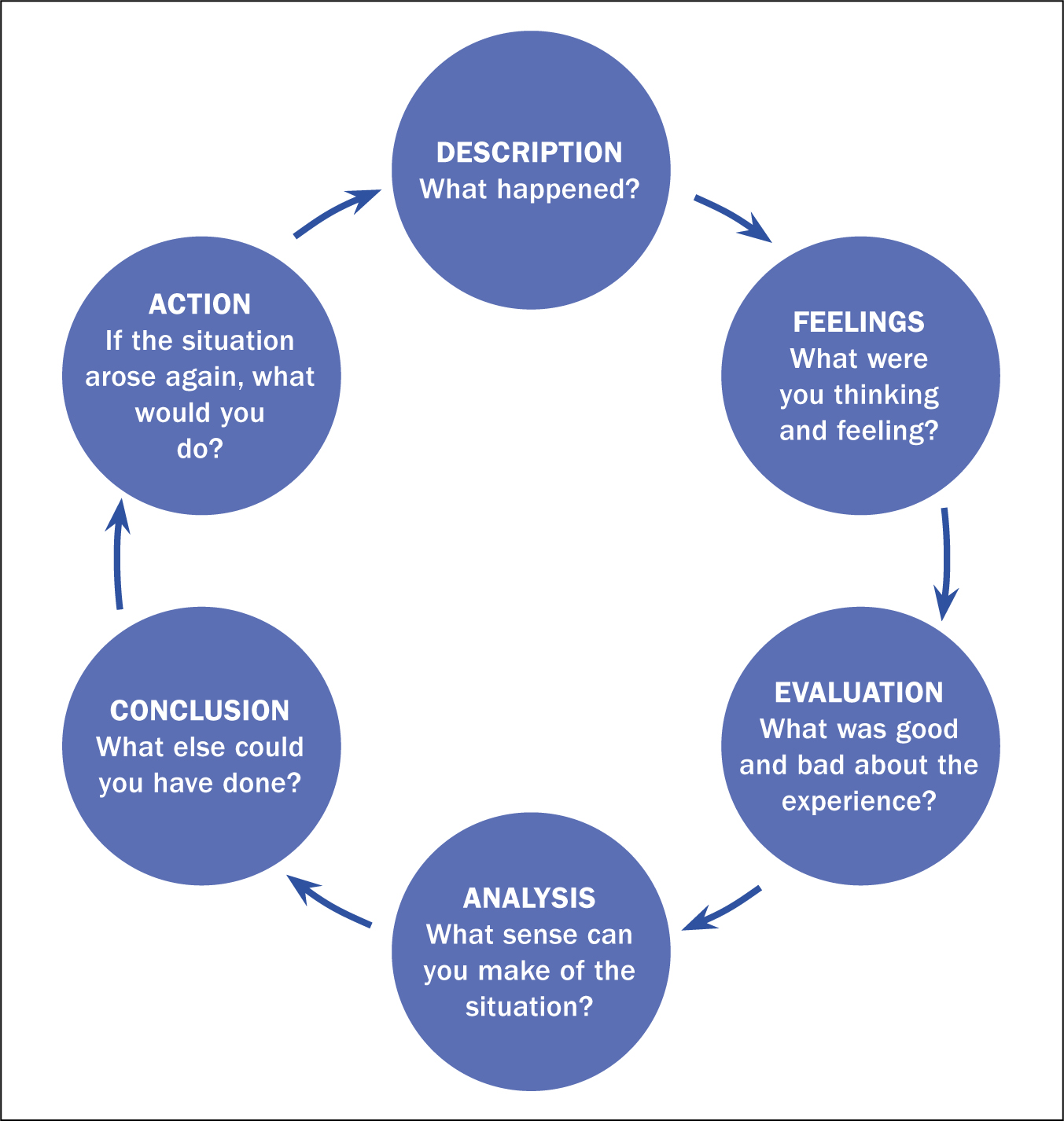
The cycle incorporates six different elements:
Gibbs' cycle was adapted by Reid (2000) who portrayed reflection as learning from and reviewing practice in order to describe, analyse, evaluate, and subsequently inform (Reid, 2000).
Schön (1983)
One of the most influential interpretations of reflective practice is the approach of Donald SchÖn (1983), who differentiated between reflection-in-action and reflection-on-action (Figure 2). Schön had an interest into how people from different professions solved work problems, and how their learning developed with experiences within their chosen profession (Reece and Walker, 2007). He published his first book, The Reflective Practitioner: How Professionals Think in Action (Schön 1983), after examining five professions: engineering, architecture, management, psychology and town planning. His approach has influenced many professions, but especially nursing and midwifery education (Quinn and Hughes, 2007). The focus of this model is the relationship between academic knowledge defined by universities and the acquisition of clinical competence in practice (Quinn and Hughes, 2007).
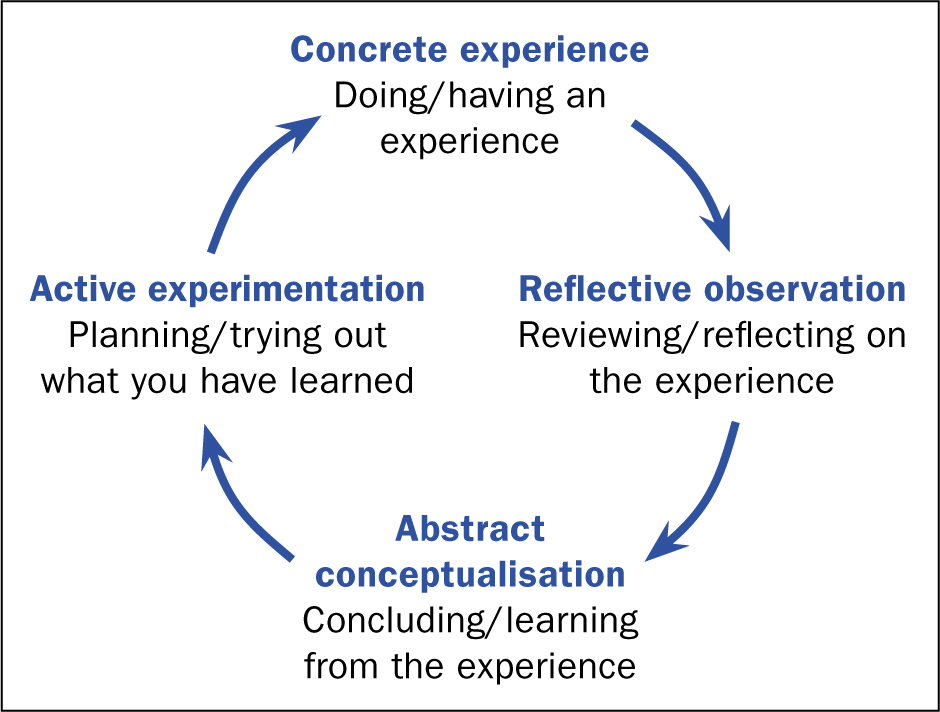
Reflection-in-action refers to the process of observing thoughts and actions as they occur in order to make adjustments in the moment. It is the process of performing ‘on-the-spot’ testing of the situation based on experience, knowledge and skills. The response is immediate, drawing on knowledge and experience as the situation unfolds (Bolton, 2014).
Reflection-on-action is the process of looking back and learning from experiences in order to affect future action. It is where students look back on and consider practice, with subsequent practice is based on this deliberation and thinking. This was later developed further by Killion and Todnem (1991) to include reflection-for-action, which evolved Schön's model to guide future action based on past thoughts and actions (Thomas, 2008). Within midwifery education, reflecting in and on action encourages consideration of thoughts and feelings to maximise self-awareness and insight (Heyer, 2015).
Kolb (1984)
Kolb (1984) proposed that a person learns through discovery and experience and produced an Experiential Learning Cycle (Figure 3) to demonstrate that effective learning takes place as students move through a four-stage cycle. The model provides a holistic model of the learning process and is called ‘experimental learning’ to emphasise the pivotal role that experience plays in the learning process.
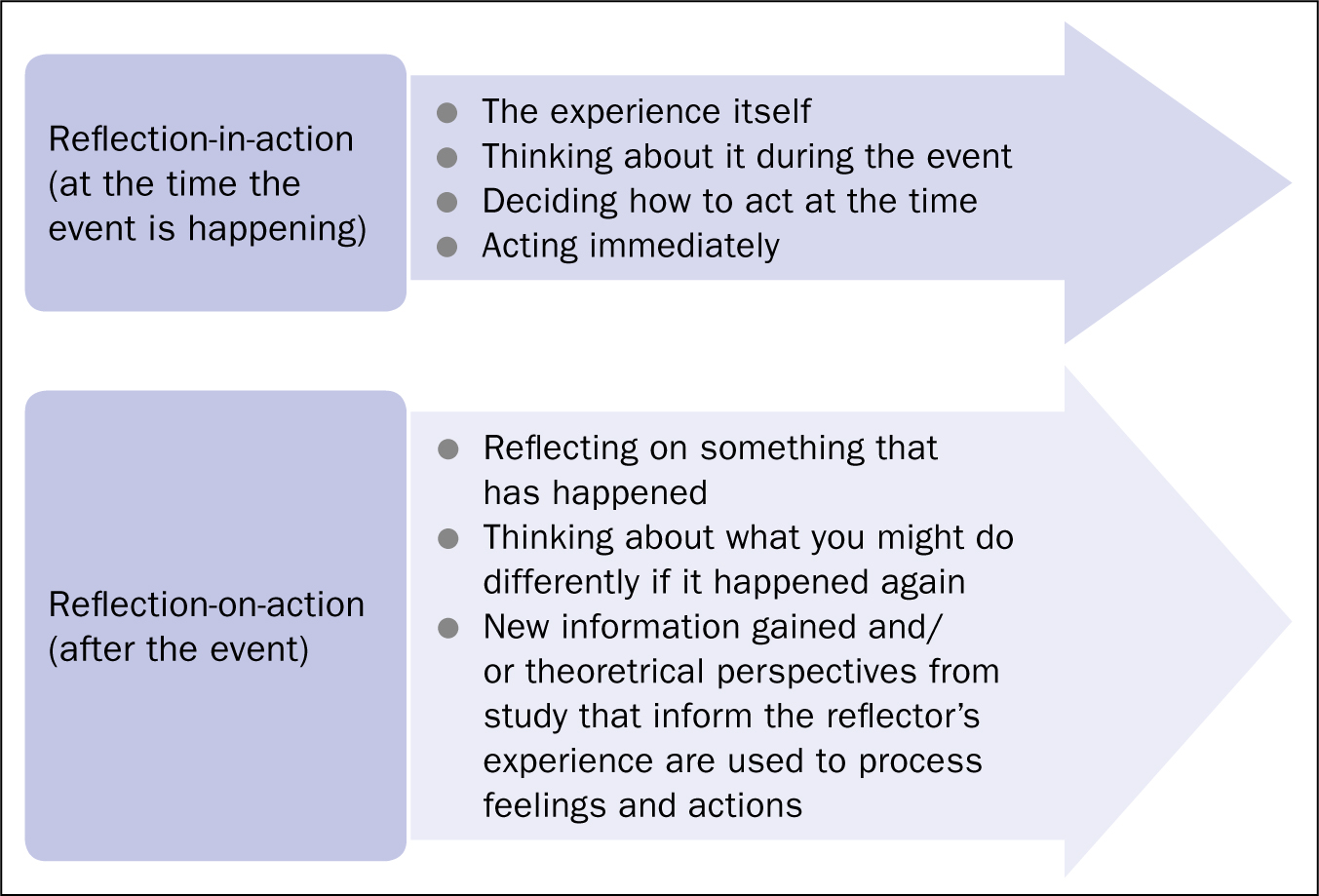
The four-stage model is used well within midwifery education to demonstrate learning and reflection during clinical placements. It consists of the following stages:
Johns' model for structured reflection (2000)
Several models of reflection feature structured sets of questions that act as cues for students to follow (Bolton, 2014). Similar to Gibb's model, when using Johns' model for structured reflection, the student looks at a particular event, its consequences and its possible development. Figure 4 demonstrates the cyclical pattern.
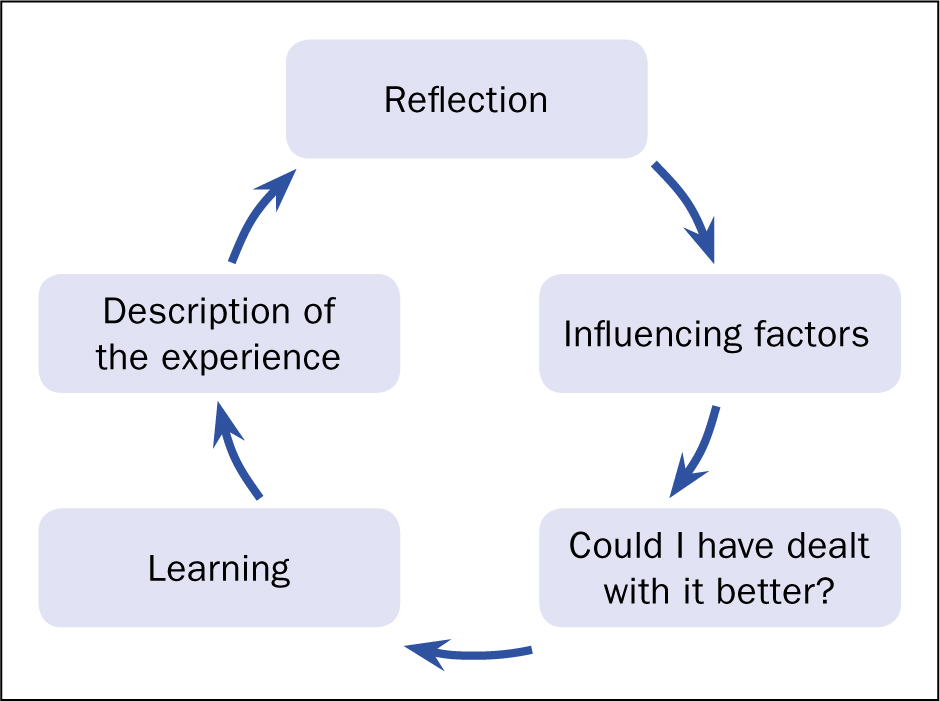
The model consists of the follwoing questions:
Johns' model was developed for nursing practitioners although it can equally be applied to midwifery. The ‘Looking In’ and ‘Looking Out’ (Figure 5) is a way of challenging a natural tendency to judge too harshly.
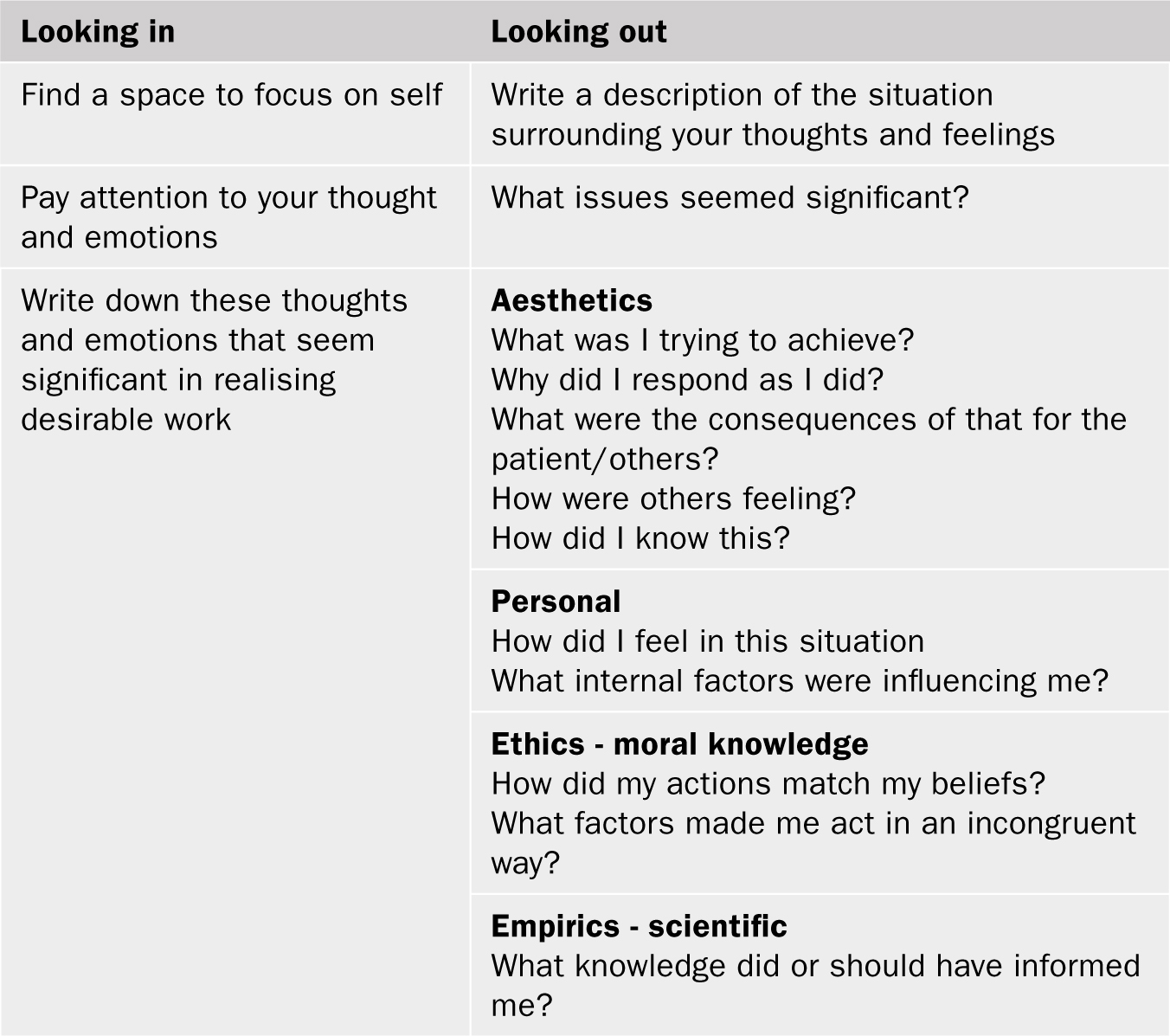
Reflective practice in midwifery education
Midwifery education follows the theories of the andragogy model and seeks to inspire critical thinking skills to promote the application of theory to practice through evidence-based research, delivered in a variety of settings and assessed by many different methods. Andragogy is the preferred term to describe the teaching and learning of adults (Quinn and Hughes, 2007), and falls within the humanistic pedagogy, which centres around life-long learning, self-motivation and self-actualisation, whereby the student has the desire to learn to fulfil their own potential (Rogers, 2002). Knowles (1990) identified four themes which made up the principle components of andragogy:
Reflection is an important element of midwifery education, and students are encouraged to use a model of reflection to demonstrate their ability to reflect in and on their experiences during clinical practice. Students provide written reflective evidence of their placement experiences, which then form part of the summative, tripartite review required for practice assessment. Following each placement, students also have reflective discussions to allow them to consider, share and evaluate their clinical experiences within a safe, confidential environment where they are encouraged to think about how events may shape and inform future and actions (Hinchcliff, 2009). Disclosing activities, elements of practice, thoughts and ideas may, however, appear unnerving or daunting at first, so the facilitator will need to develop their own teaching methods to encourage the students to share experiences.
Reflective practice can enable professionals to use an experience to learn about themselves, their work, the relationship between the personal and the professional, and the wider society and culture (Bolton, 2014). However, if reflection is to be considered as a valid learning tool, it should be combined with critical thinking (Nicol and Dosser, 2016). Midwifery professionals face challenging, complex and unpredictable situations that need appropriate reflective and reflexive processes. Reflexivity is the process of understanding and questioning attitudes, values, assumptions and prejudices to understand a role in relation to others (Bolton, 2014). It enables conscientious and ethical action and develops self-awareness of how views are determined depending on cultural or social norms.
Being able to critically reflect on experiences allows practitioners to explore difficult situations and enables enquiry into thoughts, feelings, beliefs, values (Bolton, 2014). Critical thinking provides the knowledge and understanding to draw conclusions about an experience, to learn from the event and form an action plan for future practice (Nicol and Dosser, 2016).
The Nursing and Midwifery Council (NMC) (2008) advocates that teachers should ‘promote the development of enquiring, reflective, critical and innovative approaches to teaching’ and that a range of teaching strategies in different settings should be implemented to facilitate the integration of learning from practice and academic settings (NMC, 2008). Brown (2013) proposes that experiences are multi-sensory, and are felt, smelled, heard and touched. Students are therefore also encouraged to use creative reflection in the form of drawing, poetry— or even by using coloured Lego bricks—to symbolise learning through reflection of the experience (Nerantzi and Despard, 2014).
The students work individually, in pairs or in groups, to build a model that represents a certain aspect of clinical practice, and to explain its features. This verbalisation is a necessary stage of the reflection process, since particular meanings or features are attached to the models. By working with metaphors and symbols in this way, the reflective activity allows for deeper levels of engagement with a specific event. Students use their drawing or model to reflect on their experiences and the process of reflection itself, gaining further insight and allowing for deeper understanding. Such sessions are important to allow students to develop the critical thinking skills to prepare for them lifelong learning and reflection during their professional careers.
Continued professional development and revalidation
As part of NMC revalidation, midwives are now required to demonstrate their fitness to practise by providing evidence of reflection on clinical practice and professional development (NMC, 2017). Revalidation is the process that all registered midwives and nurses must follow in order to maintain their professional registration with the NMC, and thus protect the public by evidencing that their clinical practice meets the Standards of The Code (NMC, 2015). Reflection is one way of using experiential knowledge to enable professional and personal development to demonstrate continuous, life-long learning. The NMC requires midwives to use feedback as an opportunity for reflection and learning to improve practice, with the revalidation process stipulating that professional practitioners provide examples of how this has been achieved by reflecting on both practice and continued professional development during each three-year registration period (Nicol and Dosser, 2016). The NMC Code (2015) states that midwives must ensure that their knowledge and skills are up-to-date, in order to fulfil their professional requirements to maintain their registration. This may be achieved by participating in and reflecting on continued professional development activities in order to maintain competence and improve practice (Nicol and Dosser, 2016).
Conclusion
Reports on midwifery care often highlight the challenges that students and midwives face when meeting the demands of contemporary practice. Continuous learning and professional development is required to enable professionals to adapt to the changing landscape of midwifery care, and reflection (and the development of reflective skills) forms part of this progression to demonstrate ongoing education. Reflection can empower midwives to make decisions about individual learning requirements, and by becoming a reflective practitioner, this ultimately increases self-awareness, self-identity, and personal growth, leading to greater job satisfaction and professional fulfilment (Heyer, 2015).

